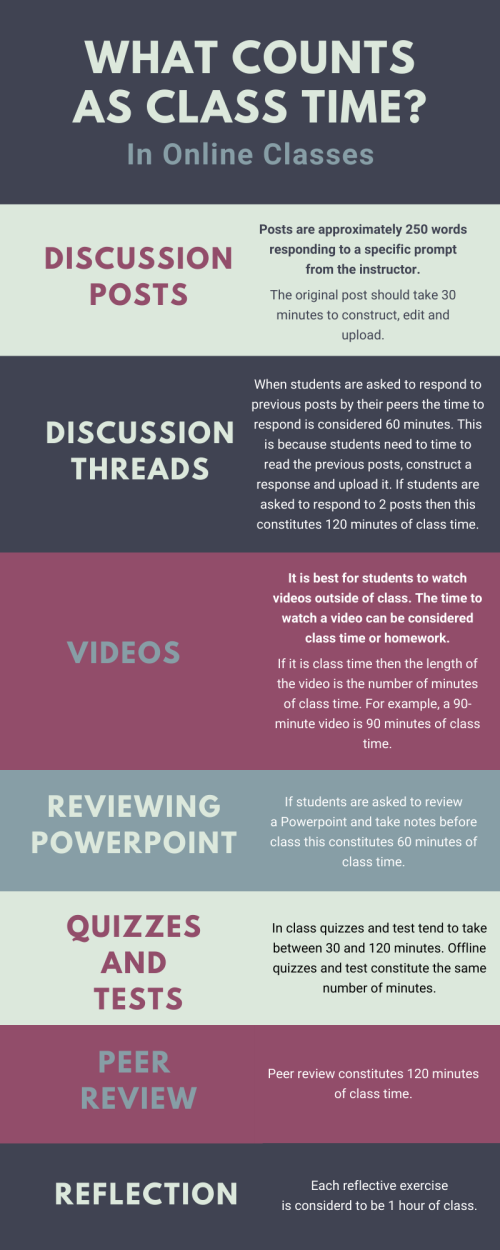By Karen Swanson, Director of Faculty Learning Groups and Scholarship
Congratulations! In the last two weeks, you have hustled to design and teach your courses in an online format. Now, it is important for us to consider the best practices for student engagement in an online class session. This blog post summarizes a few of the most popular Canvas tools used by faculty and how to adjust face-to-face (F2F) time when implementing activities such as discussions, reflections, and assessments.
Remember, time and rigor are not synonymous, a long lecture with PowerPoint may not be as effective as a varied, active approach to learning online. Our goal is to provide DU students with interesting and engaging experiences this quarter. The research suggests that the average adult attention span is 10-20 minutes (Bradbury, 2016; Wilson & Korn, 2007). Therefore, what was a two-hour (120 minute) lecture in the F2F environment can be reconfigured as a 20-minute lecture, followed by 20 minutes of breakout sessions for small group discussion, and then another 20 minutes of lecture. This constitutes 60 minutes of course time. You can now have students post a discussion thread online (see table below) to reinforce their processing and understanding of the lecture topic for the last 60 minutes. This will total the required 120 minutes of contact minutes for the week.
20 min lecture + 20 min breakout discussion + 20 min lecture + discussion post (60 min) = 120 minutes of class time
While Canvas and Zoom are making the transition from F2F to online feasible, the amount of time related to instructional design becomes less visible. It is important to consider that the activities you would have done in class now take time at home for students. Remember that even though you don’t see the student doing a discussion or quiz, this is still considered class time rather than homework. The time it takes students to complete a task through Canvas may not be readily obvious.
Traditionally, a one-credit course is equivalent to 50 minutes of F2F instruction. Thus, a three-credit course would equate to 150 minutes per week of instruction. But how does this translate for DU faculty and students working together in Zoom and via Canvas? Minutes are a useful gauge to use when designing in-class (on Zoom) and out-of-class instruction. In the following table, we summarize information from the University System of Georgia which has created a list of online activities and how many minutes of class time they constitute.
Alternative for students with low bandwidth
Another reason to vary your course delivery is based on the students’ ability to get online and into the Zoom session. It is important to remember that students and faculty may have a wide range of bandwidth or connectivity when trying to join Zoom. You might find this blog written by Daniel Stanford helpful when trying to work around online teaching issues, Videoconferencing Alternatives: How Low-Bandwidth Teaching Will Save Us All. Many of the author’s suggested are addressed in the infographic above and clearly constitute engaging and appropriate use of class time.
As Week 1 of class comes to a successful end, keep in mind that we are committed to the DU promise of meaningful faculty and student connections and robust intellectual engagement. As a community of learners, we know that trust, engagement and good will create a positive learning environment.
If you have questions about how to design Canvas activities for your classes, you can make an appointment with any Office of Teaching and Learning consultant.
Resources on Attention Span:
Bradbury, N.A. (2016). Attention span during lectures: 8 seconds, 10 minutes, or more? Advances in Physiological Education, 40, pp. 509–513. https://doi.org/10.1152/advan.00109.2016
Wilson, K. & Korn, J.H. (2007) Attention during lectures: Beyond ten minutes. Teaching of Psychology, 34(2), pp. 85-89, doi: 10.1080/00986280701291291




